Flight Lieutenant Matthews was posted and his departure “keenly felt” but his successor, F/O Biggers, proved to be as well liked. Everyone at the camp enjoyed its relaxed atmosphere and the less stringent discipline. To the pupils, it was a welcome break from Kingston where, one said, “the pressure to pass us all through as quickly as possible was considerable.”
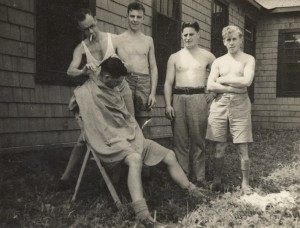
A relaxed haircut on a hot summer day.
The man with the scissors is barber Cliff Pollard. He married a local girl and returned to Kingston to live.
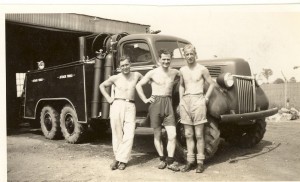
“The Farm” Crash tender at the ready and the airmen took the opportunity to get a sun tan as well.
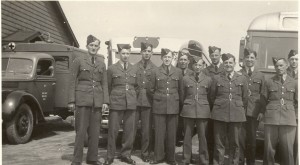
Ready to board for a bus trip:
Ron Steele of Hazel Grove second from left; Bob Fidler from Bury, second from right front row.
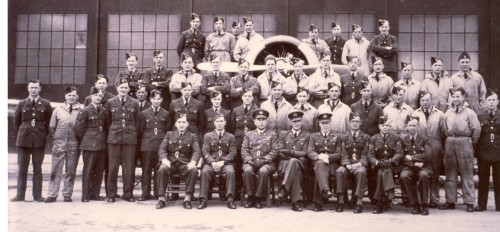
These three airmen in the back row married local girls and returned here to live: 2nd from Left Wilf Perkins married a Newfoundland girl working in Gan; behind is Reg Watkins who married Helen Halliday; extreme right is Ken Hunter who married Thelma Maxwell. Standing left front is Sid Mercer who returned with his wife and lived in Windsor, Ontario. He remained a close friend of O’Gorman Vincent.
Forty F.A.A. pupils graduated with No. 61 Course on November 20 and on the same day another young man was killed while night flying.
A/LA Harry Holman – November 20, 1942
A/LA Harry Holman was killed as a result of a flying accident during night flying operation. He was the 19-year old son of F/O Harry Ernest Holman, R.A.F. (V.R.) and Isabelle Stevenson Holman of Dundee, Scotland.
Lieut. R. C. Edwards – November 28, 1942
Lieut. Robert C. Edwards was authorized to carry out front gunnery air firing on drogue according to A.T.S. gunnery syllabus, exercise to be carried out on the Amherst range. The Court of Inquiry report said:
“The attacking aircraft made a normal approach on the target which was towed by Lysander 2411 with Sgt. Southworth as pilot. Lt. Edwards pulled out of his dive and went into a normal steep climbing turn on the right. Then 2 or 3 yellow objects left Harvard 863 which carried on for about 300 yds. The aircraft then went into a vertical dive at which time the pilot abandoned the aircraft by parachute. Sgt. Southworth followed the pilot down, saw him free himself from the parachute after landing in the water, and saw him commence to swim away. Sgt. Southworth then proceeded to the vicinity of the aerodrome, radioed the fact that the pilot had baled out and returned to the scene of the accident coming down to 100 ft. and a second time saw Lt. Edwards in the water. Sgt. Southworth tried to attract the attention of some people on shore and did all he could to bring help to the aid of the pilot. Help was rushed from the Unit but arrived too late to rescue Lt. Edwards and no trace was found of him. The parachute was picked up and a few other objects, but the aircraft was lost in about 5 or 6 fathoms of water. There was only one witness to the accident: Drogue operator LAC Ryan.”
The conclusion of the Inquiry was that the side panels of the fuselage came loose. On previous occasions at very high speeds, these have been known to come loose. The actual cause of the accident or why the pilot was forced to abandon the aircraft is obscure. The pilot was a very level-headed officer and would not have abandoned his aircraft unless it was absolutely necessary.
Apparently the life jacket worn was not sufficiently buoyant in itself to hold the pilot above water without inflation. Movement seen by the drogue operator and Lysander pilot which was interpreted as swimming might have been feeble struggling. Through the low temperature of the water and the shock of being forced to abandon the aircraft might have caused sufficient reaction to the pilot to cause him to drown. With the wind and sea in the condition they were at the time of the accident and for the ensuing 3 days, it is doubtful whether the body will be found for many months.
Twenty-four-year-old Lieut. Edwards was the son of Edgar Cecil and Bertha Susannah Edwards of Llangranog, Cardiganshire, Wales. His body was unrecovered and his name is commemorated on the Fleet Air Arm Memorial in Somerset.
On December 18, thirty-eight naval ratings reported for inclusion in Course No. 71; one was withdrawn from training on Course No. 70 at his own request on day of arrival. Course No. 63 graduated on the 20th with two officers and forty-one naval ratings successfully completing the course, and on the 29th, No. 64 Course graduated with thirty-eight naval ratings.
In December 1942, there were 31 half-days and 20 nights unfit for flight training. Instructor Trevor Dossett, who had spent a couple of years flying with a Spitfire Squadron, remembers his first winter at Gananoque.
“The whole area was completely snowed in and they couldn’t get to us from Gananoque by road to supply us and someone got the bright idea of sending me over to Kingston for a couple of sacks of potatoes. I flew over in a Harvard and found that it is true, if you lose your way in the snow you go in a semi-circle. So a beautiful semi-circle runway had been carved out for me. It was wide enough to skid around and land, and by the time I was ready to take off, it had been straightened out.”
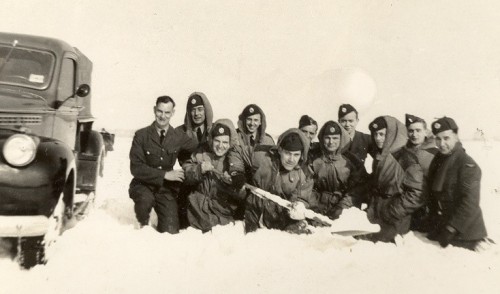
The British airmen are pictured tackling an unusually heavy Canadian snowfall.
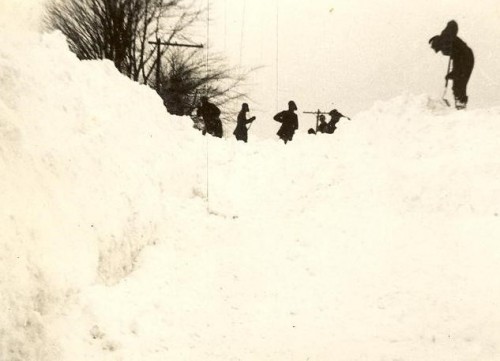
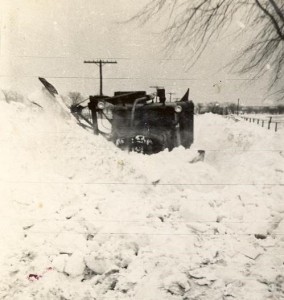
Help is arriving in the shape of a township snow plow.
When the R.A.F. first arrived in Kingston during a heavy Canadian snowstorm,
Instructor George Holloway made the remark that the English didn’t know how to deal with snow. But, they quickly learned.
Bob Fidler recalls an incident he was involved in his first winter at Gananoque which earned him 14-days CB and a fine:
“We had no runways when the snow came. They used to roll the whole of the airfield with heavy rollers towed by tractors. When flying was on, we used to lay a flare patch with paraffin lighted goosenecks. In the early hours of the morning, the wind changed direction so we had to lay another flare patch. I had an electrician with me and on the way back he asked if he could drive, and I agreed. We used to make the vehicle skid on the drome in the dark for fun. This silly bloke waited until he got near the hangar, clamped the brakes on and the next thing I saw, we were heading for a plane parked on a strip in front of the hangar. The next second, we hit the plane and the prop came through the roof between the electrician and me. You can just picture it, what it looked like when the day staff paraded. Lots of photographs taken. I was brought out of bed and put on a charge – 14 days confined to camp and a $30.00 fine. The electrician – no charge. He was smart enough to keep his mouth shut.”
AC2 K. G. Moorhouse, R.C.A.F.
December 27, 1942
At 8.38 p.m. a thirteen car troop train from Western Canada telescoped into the rear of the stationary local carrying wartime holiday passengers from Petawawa to Ottawa. The three rear carriages were shattered upon impact and after the debris was inspected there were thirty-six passengers dead and more than 150 injured. The accident occurred at the Almonte station and among the dead was AC2 Kenneth George Moorhouse R/150240 from the Kingston airport. The twenty-five-year-old was the son of John Hartley Moorhouse and his wife, Bertha Jane. He is buried in the Arnprior (Protestant) Cemetery.
F/L Alan Blyth, R.A.F.
The death of Flight Lieutenant Alan Blyth, who arrived at Kingston in 1941, occurred at the Christie Hospital in Toronto on January 4, 1943. His name is on the Ottawa Cremation Memorial at the Ottawa (Beechwood) Cemetery.
A story was carried in the Toronto Star which high-lighted the training of the naval pilots at No. 31 S.F.T.S. Kingston.
TORONTO STAR – JANUARY 26, 1943
“In the clear blue sky of a Canadian winter, thousands of feet above Norman Rogers Airdrome at Kingston, hundreds of Britain’s young naval fliers who cut their teeth at Narvik, Crete, Matapan and North Africa, train for another crack at their Axis foes.”
One of the officers profiled was 20-year-old Sub-Lieut. Ian Gilchrist, who had seen three years of active service. The young English officer figured in the capture of a German raider and saw his ship sunk. He recounted the attack:
“We were steaming along all alone when the Japs came up. Our ship was put under in 10 minutes. We got three of the blighters, however. It was purely luck that a motor boat broke loose and floated off. We put some fifty of the worst casualties in the boat. The remainder hung on to the wreckage. We were several hundred miles from land and in the worst shark area in the world. We had just refueled prior to the attack and 3,000 tons of oil were spread out on the surface. This saved all but three of our men from the sharks. These men were on the fringe of the oil patch and didn’t have a chance. The rest of us were right in the middle of the patch and the sharks refused to venture in the middle of the patch and the sharks refused to venture into it. They seemed to be afraid of oil. We could see them at a distance as if they were waiting for some of us to drift to within their reach. After some 30 hours in the water, we were picked up by one of our boats.”
Another, Sub-Lieut. Edward Thornhill, served on a British cruiser and was torpedoed off Crete. They managed to bring the badly damaged ship to Alexandria; later the cruiser took part in the hunt in the Indian Ocean for the pocket battleship Graf Spee. *Chief Petty Officer Brian Dearnley from Hull helped bomb Tripoli when that port was in the hands of the Axis. A tail-gunner in a naval plane, he was shot down into the Mediterranean during the action. The 23-year old airman served for a time on the Ark Royal and saw action at Matapan, Crete and Norway. They now transferred to pilot training in the naval arm branch.
(*see In Memoriam)
P/O A. D. Walford, R.A.F.
A/LA Michael Beachcroft, R.N.F.A.A.
2 February 1943
On 2 February 1943, one Harvard was seriously damaged and another totally damaged when they collided in mid-air while engaged in formation flying exer- cises. Instructor P/O Arthur Daniel Walford, age 21, and pupil A/LA Michael Beachcroft of Course 69 were both killed when their aircraft crashed about 1-1/2 miles from Westbrook. The second aircraft made a forced landing some distance from the airdrome. The funeral service for P/O Walford was held at Beth Israel synagogue with burial in the Jewish Cemetery at Cataraqui. He was the son of Walter and Mina Walford of Cricklewood, Middlesex, England. Nineteen-year old A/LA Beachcroft is buried in the military section at the Cataraqui Cemetery. He was survived by his parents Major Maurice Beachcroft, O.B.E. and Mrs. Beachcroft of Chalfont, St. Giles, Buckinghamshire.
At the Court of Inquiry testimony was given by the pupil and instructor in the second aircraft: F/L Peter Patterson and A/LA Michael Alwyn Vickers FX90727. Testimony by Vickers stated that he took off on a formation exercise with his instructor in Harvard II aircraft AJ643: “We were one of three machines and when the accident took place were occupying number three position on the port side of the formation flying at about 3500 feet. I had the controls and the time was about 1415 hours. F/L Patterson suddenly said, “I have the controls” and we dropped out of formation. Looking round to see the reason for this, I saw a Harvard aircraft 500 or 600 feet below and 300-400 yards in front of us, diving. It looked as though it was a dive preparatory to a loop. If that had been the case, there would have been a danger of the machine colliding with the formation. In my estimation, we dropped some one or two hundred feet below the formation and F/L Patterson dipped the aircraft’s left wing in order to follow the course of the diving machine. I lost sight of the diving machine and turned round to see what had happened to our formation. The leading aircraft was above and almost on top of us. The pilot in the leading machine must have seen us at the same time and I think it was his intention to do a climbing turn to the left. Events moved so quickly, however, that it is difficult to say what actually did happen, but he appeared to actually bank on to us. The other plane came down on top of us, the collision was only momentary. Our machine went down in a steep dive. F/L Patterson told me to jump but I was unable to open my hood. I signalled F/L Patterson to this effect and tried to pull the machine out of the dive. I think it was with F/L Patterson’s and my own combined efforts that we managed to do this. Whilst I was trying to pull my hood open, I saw the other machine going down in a steep dive and it looked perfectly intact.”
Witness S/L Brian Bryce Bridges R.A.F. was in the ambulance that picked up A/LA Vickers who was suffering from a slight concussion and F/L Patterson who was uninjured but somewhat shocked. S/L J. R. Grant, G/C and OC A.T.S. in the absence of W/C Lamb testified that F/L Patterson, who had nine years flying experience, was one of the most experienced and reliable pilots in A.T.S. He held an A2 Category, CFB Trenton and had been highly recommended by the present OC A.T.S. No. 32 S.F.T.S., Moose Jaw.
Witness A/LA Sydney Cowsill 90677 was under instruction with Sgt. Strange in Harvard AJ653. (Sgt. George Strange was staff pilot “L” Flight A.T.S.) The pupil testified that he didn’t actually see the collision but said he “had seen the aircraft in No. 3 position pull away 6 or 7 spans and return towards the leader again. This all happened in a matter of a few seconds. Sgt. Strange was in control of our aircraft at the time. I was concentrating on the leader and only saw the other aircraft more or less out of the corner of my eye. As No. 3 aircraft came back, he seemed to get too close to the leader and the leader raised his port wing and turned towards the aircraft. Sgt. Strange had to do the same and I lost sight of both the other aircraft when the port wing of my aircraft raised up.”
F/L Peter Patterson, R.A.F., O.C. “L” Flight A.T.S., testified: “After having carried out about 45 minutes of the formation exercise during which myself and Sgt. Strange had acted leader alternately, Sgt. Strange handed over leadership to P/O Walford, then at 3500 feet and flying in a westerly direction, I saw another aircraft to the right slightly in front and approximately 700 feet below our formation diving as if to commence a loop. Considering there was risk of collision with this aircraft, I signalled to P/O Walford by nodding my head to turn left and then I broke formation in order to keep the diving aircraft in sight.”
On February 4, twenty-four naval ratings reported for inclusion in Course No. 74. On the 5th, Course 66 graduated with three officers and twenty-nine naval ratings receiving their wings. Also on the 5th, a pupil decided to carry out a practice forced landing, an exercise he was unauthorized to do. He flew so low that the propeller struck the ground. He was awarded 15 days’ detention.
A/LA Hugh McNeice – 8 February 1943
Gananoque Airport
A pupil in Course 67, A/LA Hugh McNeice, was killed on February 8 when two Harvards were engaged in practice formation flying exercises and collided. His plane, which exploded over an area of 500 square feet, crashed on the farm of Murray Day, two miles east of Gananoque. The other pilot, whose plane flipped over as he landed in the field north of North Street near James Street, was uninjured. After crawling out of the cockpit, he made his way to a nearby home. The pupil reported to the station: “We collided in mid-air and my plane apparently burst into flames, making it impossible for me to see where I was going.” The 19-year old pupil was the son of Hugh and Rosina Ethel McNeice, of Lee, London, England. He is buried at the Cataraqui Cemetery.
On February 19, three officers and thirty-one naval ratings graduated with Course 67. And on the 27th, thirty-three naval ratings arrived for Course 75.
This is from a F.A.A. website and explains the hazards of being a naval pilot: “Against the Italian fleet the first function of the carrier’s machine is to fly out – perhaps 200 or 300 miles – to spot the enemy. This done, they wireless the enemy’s position back to their ship or fly back to it themselves. Perfect navigation is required for the fleet aeroplanes have to find the tiny spot of their carrier’s deck in hundreds of miles of ocean, and this spot may have moved many miles in any direction since they left it. Planes are then sent out to attack and, if possible, damage the enemy fleet sufficiently to lessen its speed and make it easier for the British fleet to catch it. After delivering their attack the planes fly back to their carriers. When the fleets ultimately join battle, the planes take off again and act as spotters for artillery fire.”
Air Vice Marshall A. E. Godfrey M.C., A.F.C., V.D., and A.D.C
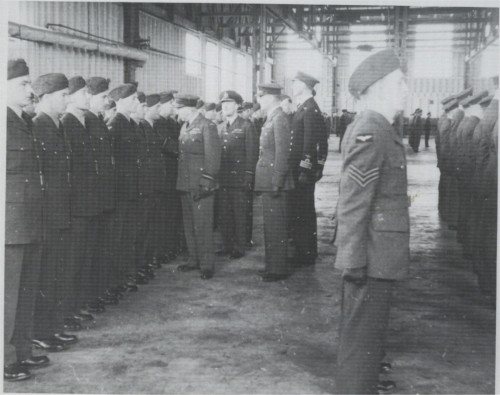
On March 2, 1943, Air Vice-Marshal A. E. Godfrey, the Deputy Inspector General of the R.C.A.F., carried out an inspection of the camp. He was extremely pleased with what he saw.
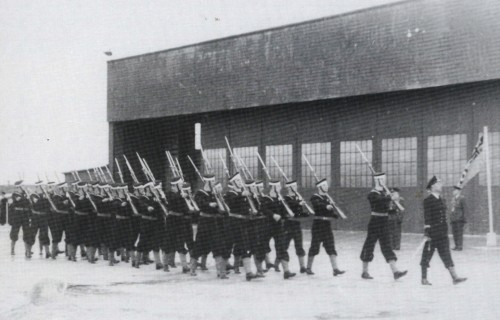
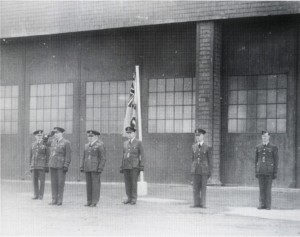
AVM Godfrey was another close tie to the town of Gananoque as he was married to Dora Bulloch of the Parmenter & Bulloch rivet company which was situated at the St. Lawrence water-front. His interest in flying began overseas in 1916 when he transferred from the army to the Royal Flying Corps. He won the Military Cross for his distinguished record as a fighter pilot. In 1918 he transferred to the Royal Air Force in Canada with the rank of squadron leader and named commandant of the School of Aerial Fighting at Beamsville and for his work there was awarded the Air Force Cross. In 1922 he joined the R.C.A.F. to take command at Camp Borden; in 1926 he made the first trans-Canada seaplane flight; and in 1928, the first airmail flight across Canada. In October 1939, he became Air Officer Commanding Western Air Command. In December 1941 he went to R.C.A.F. Headquarters to fill the post of Deputy Inspector General and retired in 1944.
A group of fourteen naval ratings arrived on March 3 to train in Course No. 76. On March 5, Course No. 68 graduated with two officers and thirty-three naval ratings receiving their pilot wings. No. 69 Course graduated on March 19th with thirty-three naval ratings successfully completing the course. On the 28th, thirty-eight naval ratings arrived. Course No. 70 graduated on April 1 with four officers and thirty-four ratings receiving their wings.
A/LA Hugh V. Laing – April 1, 1943
A/LA Hugh Victor Laing, age 18, was carrying out training exercises near Odessa when his aircraft struck the ground. He received fatal injuries during the crash, which totally wrecked the Harvard aircraft. He was the son of Hugh and Elizabeth Laing of Fenham, Newcastle-on-Tyne. He was given a full military funeral and is buried in the military section of Cataraqui Cemetery.
Three officers and thirty-three naval ratings arrived to begin training with Course 79 on April 8 and on the 16th, two officers and thirty-four ratings graduated with No. 71. The next day, forty ratings arrived for inclusion in Course No. 80.
Kingston Whig Standard
The R.A.F. choir, which is under the direction of F/O H. S. Ellis, has made a fine reputation for itself in a comparatively short time in Kingston and in Eastern Ontario. The choir is presently engaged in a series of broadcasts from station CKWS. Featured in the concert are LAC John Whitworth, pianist, and LAC Harold Bodley, violinist. The concert party is under the direction of LAC Vic Newrock, assisted by Flt/Sgt. Dicky Thraves. The latter has been the stalwart of R.A.F. concerts in the Old country and elsewhere for many years. Stage production is in charge of Flt/Sgt. Fred Templeton.
Comedy, skits, choir selections, solos and orchestra numbers were blended together” for the presentation of the R.A.F. variety concert ‘Show Time’. The concert was in support of the fourth Victory Loan from which the proceeds went to the Commanding Officer’s Benevolent Fund.
With Vic Newrock as compere and F/O H. S. Ellis, conductor of the male voice choir leading the show, the different numbers drew tremendous applause from the capacity audience. Comedians Bob and Bert Roberts, with their sparkling comedy, found favour with young and old alike, while comedienne, Sylvia Finckle, assisted in several of the skits.”
The C/O’s diary recorded the following arrivals and departures:
On April 30, 1943, thirty-nine ratings graduated with No. 72 Course, and twenty-one naval ratings arrived on May 1 for inclusion in No. 81 Course, with another nineteen arriving on the 9th.
No. 74 Course graduated with thirty-four pupils successfully completing the course on May 28. The next day one officer and thirty-nine naval ratings reported for inclusion in No. 82 Course.
At the end of May, the unit strength stood at 97 R.A.F. Officers; 11 W/Os; 103 F/Sgts. and Sergeants; 875 ORs. Pupils numbered 4 Officers; 239 Ratings; 6 R.A.A.F. Officers; 1 Officer and 3 OR’s R.N.Z.A.F. R.C.A.F. on staff were: 3 Officers, 2 W/O’s, 57 OR’s; Naval Staff: 3 Officers, 6 Ratings; 2 Officers Army personnel (C.D.C.); and 43 Civilians.
The friendships begun at the dances were blossoming into romance and the C/O recorded in his diary that there were six weddings during the month of May and in the month of June, there were thirteen. Later August saw five more weddings and another six couples married in September.
Brock Jewellers offered a six-diamond engagement and wedding band set for $22.50 on sale for half the regular price of $45.00, which could be purchased on time for $1.25 a week. A 26-piece set of Rogers silverplate with gift box, was also on sale for half price at a cost of $5.00. While the airmen were stationed in Canada, the R.A.F. rate of pay was increased to the R.C.A.F. scale. Basic rate for a Leading Aircraftsman in the R.C.A.F. was $1.50 per day; $1.70 for a Corporal; $2.25 for a Sergeant. With an ‘A’ group trade, a Leading Aircraftsman received $2.25 per day. The wife of a serviceman received $35. a month Married Allowance and one-half of her husband’s pay.
On June 6, 1943, one officer and thirty-eight ratings arrived for 83 Course and on the 11th No. 75 Course graduated with thirty-two ratings successfully completing the course.
There was lots of excitement in the town of Gananoque when an Anson, a twin-engine aircraft rarely seen in this area, dropped in for an unexpected visit. The story was in the June 16th newspaper and it is also a first-hand account.
Spectators Escape as Bomber Crashes Where
They had Stood
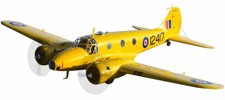
An R.C.A.F. Anson from Mountain View, which had made an emergency landing in Conner’s field (along the east side of Charles St. N. where St. Joseph’s school now stands) was attempting to take-off in the direction of Charles Street. It failed to accomplish this as it bumped over the rough ground, never gaining the speed required. It bounced and banged across the field, and the crowd scattered as it realized the plane was not going to make it. It crashed up across the ditch, onto the road and finally stopped when a wing struck the large tree in front of the double house on the corner of Charles and Georgiana Streets. The only injury was a slight ankle injury suffered by the pilot, which meant the crowd could go home having enjoyed a moment of excitement.
Residents talked about this for many years, as those on King Street thought the pilot was one of the foolhardy ones who dive-bombed for amusement, not realizing he was anxiously looking for a suitable place to land before he crashed from lack of fuel. Several took down the number in order to report it to the authorities.
Airmen from the station were posted on overnight duty at the crash site and nearby housewives filled them up with tea and biscuits. Not an unpleasant duty after all.
On June 25, a small class of nineteen ratings successfully completed Course 76. On the 26th, one officer and thirty-nine ratings arrived for inclusion in No. 84 Course.
Another tragic crash occurred from ‘dog-fighting’ as the aircraft had been seen by witnesses on the ground.
P/O F. A. Piercy and A/LA G. F. Hicks
Gananoque 9 July 1943
Believed at first to have gone suddenly out-of-control in mid-air, a Harvard from the Gananoque Airport crashed six miles west of the town near McClement’s farm shortly after noon on July 9, 1943. Both the instructor, P/O F. A. Piercy of the Royal New Zealand Air Force, and pupil A/LA Geoffrey F. Hicks were killed instantly. The McClements (David Hugh, John and his son, Howard) had been working in the field and had seen the plane flying low as they engaged in the ever popular ‘dog-fighting’ with another Harvard. One wing struck a rocky knoll to the west of the McClement road as it banked very low and then crashed. The second plane circled over the crash site and then flew off in the direction of Kingston.
The instructor and pupil had been on low-flying exercises over Howe Island at the time and the two instructors would have been at the controls during the dog-fighting. When he reported to the C/O at Kingston, the instructor said they had noticed the other plane as they were flying over Howe Island and then saw it fall. He went to locate it, and saw it had crashed in the field. It was considered by the inquiry that they were involved, but no action was taken.
P/O Frank Alexander Piercy, 23, was the son of Thomas and Agnes, and husband of Rita Ellen Piercy, Riverton, Southland, New Zealand.
A/LA Geoffrey Francis Hicks, 23, was the son of Solomon John and Winifred of Redditch, Worcestershire.
Funeral services for the two pilots were held on July 12 with Rev. McLean Gilmour conducting the service for P/O Piercey at St. Andrew’s Presbyterian Church and S/Ldr D. A. Foster conducting the service for A/LA Hicks at St. George’s Cathedral.